Why make your own fish food when you can buy it already made?
Because fish generally do better when their diets are supplemented with fresh foods than on a steady diet of processed prepared foods. Making your own fish food is also a great way to add natural color enhancers to your fish’s diet.
I’m not inclined to measure ingredients, either when I cook for people or when I make food for fish. I’ll often go with what looks good at the supermarket, or with whatever I happened to have on hand in the kitchen. So I won’t give you a fish food recipe. But I do want to provide you with some general guidelines to keep in mind when you make food for the fish that you keep. (If you’re someone who does needs to follow a recipe, then you might want to try the one developed by Kurt Johnston of the Lancaster Aquarium Society, over on the Guitarfish blog.
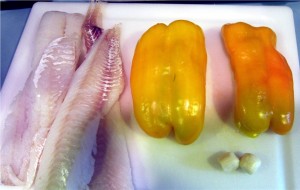
Most fish are omnivores, so any good fishfood should begin with a combination of animal and vegetable foods. Fish filet and bell peppers are a good start. Many fish also like garlic, reputed to have medicinal properties
In general, I combine fresh ingredients like fish or beefheart and fresh vegetables with dry ingredients like ground seaweed and paprika. I also add binding agents, such as gelatin and agar, to the mix. I blend all the ingredients together in a food processor, then spread the mix into a shallow baking pan and wait for it to solidify. When it’s all done, I’ll cut it into squares, which I store individually in small plastic bags, and thaw as I need it.
Animal vs. vegetable
With very few exceptions, most fish are omnivores needing a mix of animal and plant foods to thrive. So I like to combine some sources of animal protein with some greens or other vegetable component. For the animal fare, I like to start with a pound of filet from a sea-going fish, or a pound or so of beef heart, trimmed of fat and gristle. Fish living in the wild probably don’t come upon fat very often, so the dense saturated fat on beef heart or other meats might be hard for them to digest. Fish filets are naturally lean and don’t need to be trimmed. I usually go with whichever fish happens to be least expensive at the time I buy it. If price isn’t much of a concern, salmon is a good choice, because it contains color-enhancing carotenoids. (For ideas on source of carotenoids to add to home made fish food, see the page on this blog, “Fish color enhancement, explained.“)
I like to use sea-going fish to lessen the chance that the flesh might contain a bacteria or other organism that might be passed on to my fish. My reasoning is that a saltwater infectious organism would have a hard time adapting to the freshwater conditions in my tanks.
For the vegetable component, I usually add some chopped bell pepper, de-seeded, and with the stem removed. Bell peppers are a good source of vitamin C. (Like people, fish can’t synthesize vitamin C and have to consume it in their diets.) Green peppers probably have the most vitamin C. Since I like to add carotenoid rich foods to bring out the colors in my fish, I usually opt for an orange or a yellow bell pepper. Fresh snap (string) beans also work well, especially if you can get the wax (yellow) variety. Another good choice is green leaf lettuce. I tend to go with romaine, because a manatee keeper once told me that he feeds romaine to the manatees almost exclusively, because it has a high vitamin content. I don’t use sweet or starchy fruits and vegetables, such as potatoes, sweet potatoes, carrots or corn (maize). I’m inclined to think that fish don’t encounter sugars or starches in their natural environments, and that sugars and starches might cause digestive problems. Similarly, I don’t use soy or legumes for much the same reason. I also don’t include cabbage or broccoli or other vegetables containing sulphur compounds, which I think might cause problems for a fish’s digestive system.
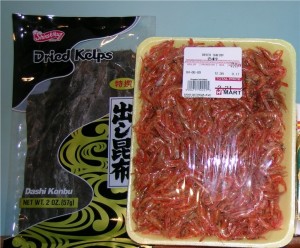
Dried ingredients absorb the water in fresh ingredients, helping to keep the water from fouling. Dried ingredients also may be sources of concentrated carotenoids.
Wet Vs. Dry
I combine the meat and vegetables with dry ingredients to soak up the excess water. I buy dried shrimp from the Asian grocery store near my house, and grind some up in a coffee grinder. Dried seaweed—also available at Asian grocery stores—is another of my favorite dry ingredients. It comes in either pressed sheets, or stalks and leaves, either of which can be ground into a fine powder. And I nearly always add a couple of tablespoons (or more) of paprika—again, for the carotenoids. Although drying foods might remove some nutrients, the drying process works to concentrate others, like the carotenoids. So paprika will contain more carotenoids than an equal amount of fresh bell pepper.
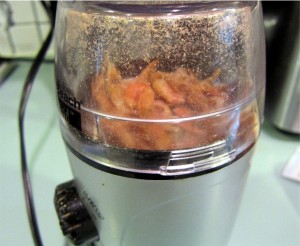
A coffee grinder is a great tool for grinding dried shrimp, dried seaweed, vitamin tablets and other dry ingredients.
Vitamins
When I’m mixing the dry ingredients together, I’ll also add a supermarket adult multivitamin and mineral tablet, which I also grind in coffee grinder. I’ll add a vitamin C tablet as well—usually from 500 to 1000 mg. Remember, fish can’t make their own vitamin C like other animals can. Vitamin C also is unstable in water. So I add a little more than I think I need, to make up for the possibility that some may be lost as the food dissolves in water.
Proportions
If you’re feeding comparatively herbivorous fish, like goldfish or mbuna, you’d probably want to add a higher proportion of vegetable matter to animal matter—maybe 60/40 or 70/30. Since my fish aren’t herbivorous, I use about 75 percent animal food to 25 percent vegetable food.
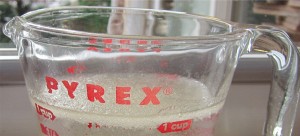
Gelatin keeps food together to prevent the water from getting cloudy. Before boiling gelatin, it's necessary to soak it for several minutes before boiling it, otherwise it won't dissolve completely.
I combine about 60 percent of the “wet” ingredients (meat, fish, fresh vegetables) with about 40 percent dry ingredients (dried ground shrimp, paprika, dried ground sea weed), to produce a reasonably dry mixture.
Binders
To keep from turning the water cloudy, I hold all the above ingredient together with binding agents. I use three: gelatin, agar, and egg yolk.
- Gelatin— available dried, in packets. (You’ll need the plain, unflavored kind, not the flavored, sugary version sold as a desert.) The gelatin powder is added to water and then boiled. As it cools, it will begin to set, or gel, forming a dense rubbery matrix. It’s important to hydrate gelatin before you boil it, or else it will clump together and not dissolve. The Gelatin Manufacturers Association of Asia Pacific has a page explaining how to work with gelatin. The mix I buy makes one cup of gelatin per packet. To make sure I’ll get a firm gel, I add two packets to one cup of water.
- Agar— also comes in powder form. Agar doesn’t need to be hydrated first, so you can simply combine a couple of packets or so in with your other dry ingredients before you combine everything together in a food processor. To convert powdered agar into its gel form, you need to add water and then heat it—but only slightly, to 200 degrees Fahrenheit, and only for 20 minutes.
- Egg yolk—another good binder. Egg yolks also have the added benefit of containing carotenoids and long chain essential fatty acids, which are especially important for baby fish. The egg yolk will be the first to solidify, when you heat the mixture to 200 degrees. (If you don’t know how to separate the yolk from the egg white, you’ll find a page on how to do so here.)
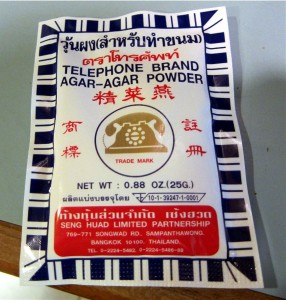
Agar is another useful binding agent. Boiling will cause it to disintegrate, so it should be heated for only a short time at low heat (200 degrees Fahrenheit.)
Putting it all together
I begin by hydrating the gelatin for 20 minutes or so, and then boiling it for five minutes, until it completely dissolves. I then set it aside to cool to room temperature, while I prepare the other ingredients. Don’t add the gelatin solution to the mix while it’s still hot—this will break down the agar and keep it from gelling. Likewise, don’t let the gelatin cool for too long, or it will solidify.
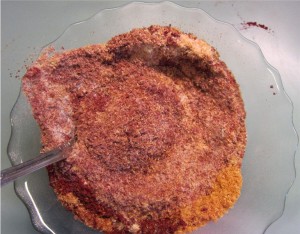
Before adding them to the wet ingredients, thorougly mix such dry ingredients as agar powder, paprika, astaxanthin, and dried shrimp.
While the gelatin is cooling, combine all the wet ingredients—meat or fish, vegetables—in the food processor until well blended. Then add the dry ingredients—dried ground shrimp, paprika, ground vitamins, agar, etc. By this time, the gelatin should have cooled to room temperature so you can add that too, along with 4 or 5 egg yolks.
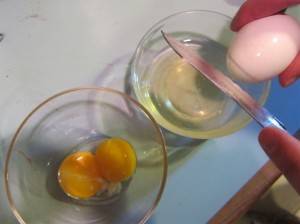
Egg yolks, separated from whites, are a useful binding agent that also provides protein and carotenoids.
Line a shallow baking pan with parchment paper and spread the mixture over the paper to form a thin layer and fill the pan. Put the mixture in an oven preheated to 200 degrees and bake for 20 minutes. Cool in a refrigerator for an hour or so, to allow the agar and the gelatin to solidify. Cut into squares, then store each square in a plastic bag and freeze, thawing each bag as needed.
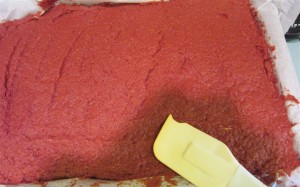
After combining all the ingredients in a food processor, spread the resulting mixture into a shallow baking pan lined with parchment paper. Bake at 200 degrees Fahrenheit for 20 minutes, then refrigerate for an hour or so. After the food has gelled, cut into squares , put into plastic storage bags and freeze until needed.
